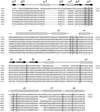A poxvirus-like type IB topoisomerase family in bacteria
- PMID: 11830640
- PMCID: PMC122283
- DOI: 10.1073/pnas.032613199
A poxvirus-like type IB topoisomerase family in bacteria
Abstract
We report that diverse species of bacteria encode a type IB DNA topoisomerase that resembles vaccinia virus topoisomerase. Deinococcus radiodurans topoisomerase IB (DraTopIB), an exemplary member of this family, relaxes supercoiled DNA in the absence of a divalent cation or ATP. DraTopIB has a compact size (346 aa) and is a monomer in solution. Mutational analysis shows that the active site of DraTopIB is composed of the same constellation of catalytic side chains as the vaccinia enzyme. Sequence comparisons and limited proteolysis suggest that their folds are conserved. These findings imply an intimate evolutionary relationship between the poxvirus and bacterial type IB enzymes, and they engender a scheme for the evolution of topoisomerase IB and tyrosine recombinases from a common ancestral strand transferase in the bacterial domain. Remarkably, bacteria that possess topoisomerase IB appear to lack DNA topoisomerase III.
Figures





References
Publication types
MeSH terms
Substances
Grants and funding
LinkOut - more resources
Full Text Sources
Other Literature Sources

